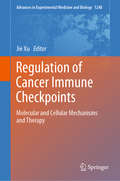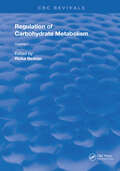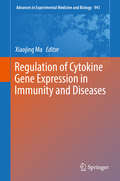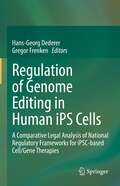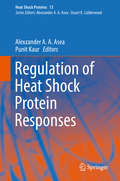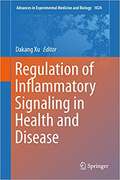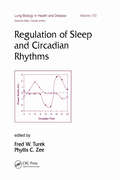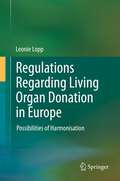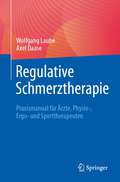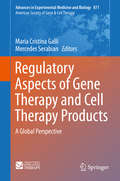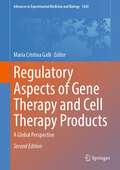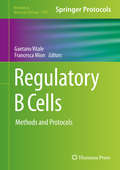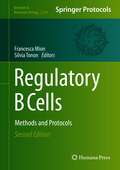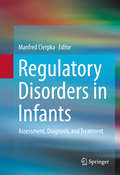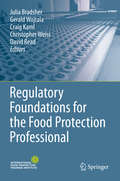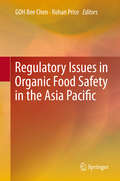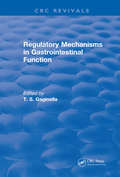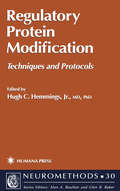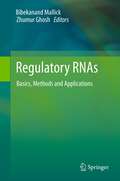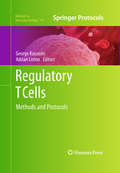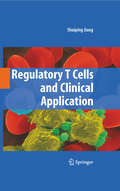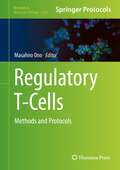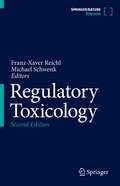- Table View
- List View
Regulation and Co-Regulation: Accessible Neuroscience and Connection Strategies that Bring Calm into the Classroom
by Ginger HealyTackling this critical aspect of learning head-on, 15-Minute Focus: Regulation and Co-Regulation holds out unapologetic hope for healing. As you absorb and apply the wisdom within these pages, get ready: a domino effect will begin when you embrace a new lens of thinking and responding. Everyone in your life - including you - will benefit from the tools you employ to make co-regulation a consistent reality for your students.
Regulation of Cancer Immune Checkpoints: Molecular and Cellular Mechanisms and Therapy (Advances in Experimental Medicine and Biology #1248)
by Jie XuThis book systematically reviews the most important findings on cancer immune checkpoints, sharing essential insights into this rapidly evolving yet largely unexplored research topic. The past decade has seen major advances in cancer immune checkpoint therapy, which has demonstrated impressive clinical benefits. The family of checkpoints for mediating cancer immune evasion now includes CTLA-4, PD-1/PD-L1, CD27/CD70, FGL-1/LAG-3, Siglec-15, VISTA (PD-1L)/VSIG3, CD47/SIRPA, APOE/LILRB4, TIGIT, and many others. Despite these strides, most patients do not show lasting remission, and some cancers have been completely resistant to the therapy. The potentially lethal adverse effects of checkpoint blockade represent another major challenge, the mechanisms of which remain poorly understood. Compared to the cancer signaling pathways, such as p53 and Ras, mechanistic studies on immune checkpoint pathways are still in their infancy. To improve the responses to checkpoint blockade therapy and limit the adverse effects, it is essential to understand the molecular regulation of checkpoint molecules in both malignant and healthy cells/tissues. This book begins with an introduction to immune checkpoint therapy and its challenges, and subsequently describes the regulation of checkpoints at different levels. In closing, it discusses recent therapeutic developments based on mechanistic findings, and outlines goals for future translational studies. The book offers a valuable resource for researchers in the cancer immunotherapy field, helping to form a roadmap for checkpoint regulation and develop safer and more effective immunotherapies.
Regulation of Carbohydrate Metabolism(1985): Volume I
by BeitnerFirst Published in 1985. A collaboration of the latest research on regulation of carbohydrate metabolism.
Regulation of Cytokine Gene Expression in Immunity and Diseases
by Xiaojing MaThis book explores the major cytokines, such as IL-1 and IFN-γ, with respect to the regulation of their gene expression and protein production in specific immune cell types. It discusses both healthy physiological settings and in pathological situations in which the expression of some cytokines could be dysregulated, resulting in either immunodeficiency or exacerbated inflammatory sequelae in animal models as well as in human patients. Cytokines are important regulators of immune responses that require the highly coordinated participation and communication of multiple cell types. The expression of cytokines by various producer cell types is therefore carefully regulated in response to environmental cues at multiple levels: transcription, translation and posttranslational modification. Presenting cutting-edge advances in our understanding of the regulation of cytokine expression, this book is a valuable resource for anyone involved or interested in immune regulation.
Regulation of Genome Editing in Human iPS Cells: A Comparative Legal Analysis of National Regulatory Frameworks for iPSC-based Cell/Gene Therapies
by Hans-Georg Dederer Gregor FrenkenThe book provides a concise overview of currently applicable regulatory frameworks of states which are among the world leaders in research and development (R&D) of cell and gene therapies. Developments in genome editing are expected to lead to new possibilities for the treatment of hereditary diseases in humans. The treatment of such often severe but hitherto uncurable diseases can be based on genome-edited induced pluripotent stem cells (iPS cells). Such treatments constitute combined cell/gene therapies. These therapies need to be governed by a regulatory framework which ensures quality, safety, and efficacy of the relevant therapeutic products. On the other hand, such regulations may retard product approval and impede R&D. Accordingly, national regulations for therapies based on genome-edited iPS cells are an important and, as the case may be, decisive factor for both researchers and industry regarding their decision where to locate their R&D activities. Therefore, regulatory frameworks impact significantly on the competitiveness of states and their economies. This is why a comparative analysis of laws and regulations of different countries matters. Such a comparative legal analysis provides an important insight into regulatory concepts which, in turn, may inspire adjustments of, or amendments to, domestic legal regimes. For this purpose, experts present country reports on France, Germany, Japan, South Korea, Switzerland, and the USA. The reports on France and Germany also refer to the parameters and implications arising from pertinent EU law. This contributed volume is aimed at researchers, but also at, e.g., legal scholars, lawmakers, regulators, and political decision makers.
Regulation of Heat Shock Protein Responses (Heat Shock Proteins #13)
by Punit Kaur Alexzander A A AseaThis books provides the most up-to-date reviews on current advances in our understanding of the regulation of heat shock protein responses. Key basic scientists and clinical research laboratories from major universities, academic medical centers and pharmaceutical companies around the world have contributed chapters that review present research activity and importantly project this field into the future. For easy readability, the book is sub divided into four sections, including, Section I - HSP and Stress Responses; Section II - Chaperone Functions of HSP; Section III - HSP in Human Diseases; Section IV - Prognosis & Diagnosis of HSP. The book is a must read for researchers involved in biomedical research, drug discovery and design to improve human health.
Regulation of Inflammatory Signaling in Health and Disease (Advances in Experimental Medicine and Biology #1024)
by Dakang XuThis book discusses recent research in innate immunity, which has revealed a large number of receptors that sense the presence of microorganisms or cellular damage in tissues. In complex tissues, many of these sensing events occur simultaneously. Thus, the downstream signaling pathways need to be integrated so that an appropriate cellular inflammatory response can be initiated. In addition, the inflammasome defines the molecular and cellular processes of inflammation in response to microbial infection. Previous data suggested that regulation of inflammasomes is mediated by microbes, but inflammasomes also have antimicrobial functions. Increasing evidence in mouse models, together with human data, strongly implicates an involvement of the inflammasome and uncontrolled inflammation in the initiation and progression of diseases with a high impact on public health. The book reviews novel aspects of functional genomics, epigenomics, transcriptomics, post-translat ional modifications, microbiome and immunometabolism in order to understand inflammatory signaling and responses, covering recent findings on the mechanisms underlying the regulation of inflammatory responses to pathogens, dysregulation of these responses in inflammatory disease, and the use of such mechanisms to boost or subdue the inflammatory response. Bridging the gaps in understanding between the fields of human and mouse immunology, it provides valuable insights into inflammatory-mediated disease and immune defense. Such innovative perspectives in both basic and clinical research promote the translation of knowledge to the clinic.
Regulation of Sleep and Circadian Rhythms (Lung Biology in Health and Disease)
by Fred W. Turek Phyllis C. ZeeProviding an up-to-date overview of the field, this state-of-the-art reference details how sleep and circadian rhythms are interconnected, revealing the impact of various disease states on, and the molecular and genetic basis for, disrupted sleep and circadian rhythmicity and their effects on physical and mental health, safety, performance, and pro
Regulations Regarding Living Organ Donation in Europe
by Leonie LoppOrgan transplantation is a much-discussed subject, and the importance of living organ donation is increasing significantly. Yet despite all efforts, too few donor organs are available to help all patients in need. This book analyses whether the national legal regulations are also partly responsible for the organ shortage in the Member States of the European Union. In addition to a detailed analysis of the various national regulations, the main arguments in favour of and against legal restrictions on living organ donation are considered. Furthermore, the European Union's authority is investigated, namely, whether it is entitled to establish statutory provisions for the Member States with respect to a harmonized regulation of living organ donation. Based on the results of the analysis, the author establishes a Best Practice Proposal for living organ donation.
Regulative Schmerztherapie: Praxismanual für Ärzte, Physio-, Ergo- und Sporttherapeuten
by Wolfgang Laube Axel DaaseDie regulative Schmerztherapie ist mit ihren physiologisch begründeten aufeinanderfolgenden Interventionen spezifisch auf die Verhinderung bzw. Behandlung von chronischem Schmerz ausgerichtet. In diesem Buch wird die gesamte nicht pharmakologische Therapiekette von möglichen Interventionen vorgestellt. Es werden dabei passiv provozierte Maßnahmen zur Schmerzlinderung und Durchblutungsförderung beschrieben, mit dem Ziel die Gewebeverhältnisse als Grundlage der Schmerzinformationen zu verbessern. Zudem werden aktive Methoden vorgestellt, z. B. das Beweglichkeitstraining von Gelenkregionen und andere aktive therapeutische Belastungsinterventionen, die den Körper in eine anti-nozizeptive Reorganisation bringen können. Das Buch ist somit ein Leitfaden für die nicht-medikamentöse Schmerztherapie und die medizinische Rehabilitation aller chronisch nicht entzündlichen und entzündlichen Erkrankungen und kann auch bei onkologischen Krankheiten angewandt werden. Als Zielgruppe werden Physiotherapeuten, Sporttherapeuten und Ärzte angesprochen, die Schmerzpatienten betreuen.
Regulatory Aspects of Gene Therapy and Cell Therapy Products
by Maria Cristina Galli Mercedes SerabianThis book discusses the different regulatory pathways for gene therapy (GT) and cell therapy (CT) medicinal products implemented by national and international bodies throughout the world (e. g. North and South America, Europe, and Asia). Each chapter, authored by experts from various regulatory bodies throughout the international community, walks the reader through the applications of nonclinical research to translational clinical research to licensure for these innovative products. More specifically, each chapter offers insights into fundamental considerations that are essential for developers of CT and GT products, in the areas of product manufacturing, pharmacology and toxicology, and clinical trial design, as well as pertinent "must-know" guidelines and regulations. Regulatory Aspects of Gene Therapy and Cell Therapy Products: A Global Perspective is part of the American Society of Gene and Cell Therapy sub-series of the highly successful Advances in Experimental Medicine and Biology series. It is essential reading for graduate students, clinicians, and researchers interested in gene and cell therapy and the regulation of pharmaceuticals.
Regulatory Aspects of Gene Therapy and Cell Therapy Products: A Global Perspective (Advances in Experimental Medicine and Biology #1430)
by Maria Cristina GalliThis book discusses the different regulatory pathways for Advanced Therapy Medicinal Products implemented by national agencies in North and South America, Europe and Asia and by international bodies in the effort of international harmonization.This book represents an update of the first edition, as it covers regulatory novelties and accumulated experience in the regions already addressed. In addition, this new edition offers a wider international perspective: new chapters are included covering Advanced Therapy Medicinal Products regulations in India, Malaysia, Spain and Thailand, the European Pharmacopoeia texts for gene therapy medicinal products as well as international harmonization programs. Each chapter, authored by experts from various regulatory bodies throughout the international community, walks the reader through the applications of nonclinical research to translational clinical research to licensure and therapeutic use of these innovative products. More specifically, each chapter offers insights into fundamental considerations that are essential for developers of Advanced Therapy Medicinal Products in the areas of product quality, pharmacology and toxicology, clinical trial design and HTA pathways, as well as pertinent ‘must-know’ guidelines and regulations. Regulatory Aspects of Gene Therapy and Cell Therapy Products: a Global Perspective is part of the American Society of Gene & Cell Therapy sub-series of the highly successful Advances in Experimental Medicine and Biology series. It is essential reading for graduate students, clinicians, and researchers interested in gene and cell therapy and the regulation of pharmaceuticals.
Regulatory B Cells
by Gaetano Vitale Francesca MionRegulatory B Cells: Methods and Protocols present the current experimental set-ups and methodologies useful for the identification and characterization of B cells with suppressive functions and for the study of their biological and immunological properties. Organized into four sections, this detailed volume covers the basic methods for the isolation and immunophenotypical characterization of specific B cell subsets from mouse and human tissues, methods for the investigation of the mechanisms of immune suppression operated by B cells, several experimental approaches for the ex vivo generation/expansion of IL-10-producing B cells, as well as procedures for the study of the immune suppressive function of B cells in specific pathological settings. Written in the highly successful Methods in Molecular Biology series format, chapters include introductions to their respective topics, lists of the necessary materials and reagents, step-by-step, readily reproducible laboratory protocols and tips on troubleshooting and avoiding known pitfalls. Practical and authoritative, Regulatory B Cells: Methods and Protocols serves as an ideal guide for immunologists as well as for cell and molecular biologists interested in the intricacies of B cell biology.
Regulatory B Cells: Methods and Protocols (Methods in Molecular Biology #2270)
by Francesca Mion Silvia TononThis second edition provides new and updated chapters useful for the study of Regulatory B cells. Organized in four sections, chapters detail basic methods for the isolation and immunophenotypical analysis of these cells, experimental approaches for the ex vivo generation/expansion of IL-10 producing B cells, molecular biology techniques for the analysis of IL-10 expression and production, and animal models mimicking pathologic settings. Written in the highly successful Methods in Molecular Biology series format, chapters include an introduction to their respective topics, lists of the necessary materials and reagents, step-by-step, readily reproducible laboratory protocols, as well as tips on troubleshooting and avoiding known pitfalls.Authoritative and cutting-edge, Regulatory B Cells: Methods and Protocols, Second Edition aims to be useful to the scientific community and serve to clarify some unsolved aspects of Regulatory B Cells research.
Regulatory Disorders in Infants
by Manfred CierpkaThis innovative book discusses current findings on regulatory disorders in infants and offers practical guidelines for diagnosis and intervention. Focusing on core infant and toddler concerns including crying, sleeping, feeding, clinginess, and aggression, it presents a developmental continuum from normal to disturbed behavior regulation and examines science-based strategies for halting this trajectory. Case examples and widely used tools illustrate diverse approaches to assessment and diagnosis, emphasizing nuances of parent-infant interactions and parents' reactions that may fail to answer, or may even exacerbate, the child's distress. And chapters outline counseling and therapy options for infants and parents, so that persistent problems do not become entrenched in children's future behavior or lead to long-term family dysfunction. Among the topics covered: Approaches to diagnosing regulatory disorders in infants. Feeding disorders in infants and young children. Developmentally appropriate vs. persistent defiant and aggressive behavior. Treatment approaches for regulatory disorders. Video and video feedback in counseling and therapy. Regulatory Disorders in Infants is an essential resource for clinicians and practitioners as well as researchers and graduate students in clinical child and school psychology, pediatrics, social work, psychiatry, and family studies.
Regulatory Foundations for the Food Protection Professional
by Julia Bradsher Gerald Wojtala Craig Kaml Christopher Weiss David ReadRegulatory Foundations for the Food Protection Professional is a comprehensive guide for the entry-level food protection professional (FPP) working in either the public or private sector. The book can also serve as a foundation for students in academic programs preparing for a career in food protection. Additionally, as the Food Safety Modernization Act (FSMA) is implemented, this book will provide valuable information for countries wishing to export foods and food ingredients to the U. S. and comply with U. S. food safety regulations. The book is based on the Entry-Level component of the National Curriculum Framework for regulators, created by the International Food Protection Training Institute (IFPTI) located in Battle Creek, Michigan. The Entry-Level component of the National Curriculum Framework contains more than twenty content areas, including Epidemiology, Microbiology, Labeling, Food Defense Awareness, Program Standards, Environmental Health and Safety, Sampling, and Allergens. Each chapter is divided into specific learning objectives aimed at equipping the entry-level FPP with the knowledge and skills necessary to successfully perform his or her job, whether in the public or private sector, and whether in food safety or food defense. Established in 2009, IFPTI is improving public health by building competency-based training and certification systems, and cultivating leadership for the food protection community worldwide. Our mission is to enhance public health by improving the protection of the world's food supply through training, certification, thought leadership, and technology. See more at www. ifpti. org.
Regulatory Issues in Organic Food Safety in the Asia Pacific
by Goh Bee Chen Rohan PriceThe book seeks to address the intersection of food organics and the emergence of a new contractualism between producers, distributors and consumers, and between nation states. Additionally, it seeks to cater to the needs of a discerning public concerned about how its own country aims to meet their demands for organic food quality and safety, as well as how they will benefit from integration in the standard-setting processes increasingly occurring regionally and internationally. This edited volume brings together expert scholars and practitioners and draws on their respective insights and experiences in the field of organics, food and health safety. The book is organized in three parts. Part I outlines certain international perspectives; Part II reflects upon relevant histories and influences and finally, Part III examines the organic food regulatory regime of various jurisdictions in the Asia Pacific.
Regulatory Mechanisms in Gastrointestinal Function (CRC Press Revivals)
by Timothy S. GaginellaRegulatory Mechanisms in Gastrointestinal Function includes a collection of contemporary topics in gastrointestinal research. The control of gastroduodenal electrolyte transport and the influence of drugs on bicarbonate secretion are reviewed in detail. The importance of the interactions between calcium and cyclic-AMP in intestinal secretion is emphasized in a comprehensive chapter that systematically addresses each link in the mechanisms that regulate chloride secretion. Other important topics included in the book are neural reflex modulation of intestinal epithelial transport, the influence of the microcirculation on intestinal secretion, and nitric oxide as a mediator of physiologic and pathophysiologic secretion. The expertise of the authors has resulted in a breadth of important contemporary topics covered in depth.
Regulatory Protein Modification
by Hugh C. HemmingsDistinguished international experts offer critical reviews of the major categories of posttranslational protein modification in neurons, as well as a comprehensive collection of state-of-the-art techniques for their analysis. They provide detailed and specific methods for studying protein phosphorylation/dephospohorylation, methylation, long chain fatty acylation, ADP-ribosylation, glycosylation, and glycosylphosphatidylinositol anchors. Using both conventional analytical and novel molecular biological approaches, these experts present important techniques and reagents and cite numerous examples from the neuroscience literature in a way that allows investigators to determine the best experimental approaches for their own systems. The book offers the most complete review of protein kinase and phosphatase inhibitor applications available.
Regulatory RNAs
by Zhumur Ghosh Bibekanand MallickRecent progress in high-throughput technologies and genome wide transcriptome studies have lead to a significant scientific milestone of discovering non-coding RNAs (ncRNAs) which spans through a major portion of the genome. These RNAs most often act as riboregulators, and actively participate in the regulation of important cellular functions at the transcriptional and/or post-transcriptional levels rather than simply being an intermediated messenger between DNA and proteins. As the appreciation for the importance of ncRNAs continues to emerge, it is also increasingly clear that these play critical roles in gene regulatory processes during development and differentiation. Further, regulatory RNAs are useful biomarkers for diagnosis of diseases. Hence these RNA regulators are essential to the development of therapeutics. This book on "Regulatory RNAs" offers a comprehensive view on our current understanding of these regulatory RNAs viz. siRNA, miRNA, piRNA, snoRNA, long non-coding RNA, small RNA etc. It addresses both the biogenesis and mechanism of action of regulatory RNAs with a primary focus on their annotation, experimental methodologies (microarray, next-gen sequencing etc.) for their discovery, computational tools for their prediction, and above all, applications of these revolutionary regulatory molecules in understanding biological systems and diseases, including therapeutics. This comprehensive volume is intended for readers with research or teaching interests in ncRNA biology and will provide a major information resource on current research in the fast-moving fields of RNA and gene expression regulation. Cutting-edge and concise, "Regulatory RNAs: Basics, Methods and Applications" promises to support vital research in the field of regulatory RNAs, ever-continuing to grow rapidly and gain increasing importance in basic and translational biology.
Regulatory RNAs: Basics, Methods and Applications
by Bibekanand Mallick and Zhumur GhoshRecent progress in high-throughput technologies and genome wide transcriptome studies have lead to a significant scientific milestone of discovering non-coding RNAs (ncRNAs) which spans through a major portion of the genome. These RNAs most often act as riboregulators, and actively participate in the regulation of important cellular functions at the transcriptional and/or post-transcriptional levels rather than simply being an intermediated messenger between DNA and proteins. As the appreciation for the importance of ncRNAs continues to emerge, it is also increasingly clear that these play critical roles in gene regulatory processes during development and differentiation. Further, regulatory RNAs are useful biomarkers for diagnosis of diseases. Hence these RNA regulators are essential to the development of therapeutics. This book on “Regulatory RNAs” offers a comprehensive view on our current understanding of these regulatory RNAs viz. siRNA, miRNA, piRNA, snoRNA, long non-coding RNA, small RNA etc. It addresses both the biogenesis and mechanism of action of regulatory RNAs with a primary focus on their annotation, experimental methodologies (microarray, next-gen sequencing etc.) for their discovery, computational tools for their prediction, and above all, applications of these revolutionary regulatory molecules in understanding biological systems and diseases, including therapeutics. This comprehensive volume is intended for readers with research or teaching interests in ncRNA biology and will provide a major information resource on current research in the fast-moving fields of RNA and gene expression regulation. Cutting-edge and concise, “Regulatory RNAs: Basics, Methods and Applications” promises to support vital research in the field of regulatory RNAs, ever-continuing to grow rapidly and gain increasing importance in basic and translational biology.
Regulatory T Cells
by Adrian Liston George KassiotisDriven by methodological success in identifying reliable lineage markers, regulatory T cells have quickly been recognized as the most numerous subset of immune regulators in the body with critical functions in a wide array of immune responses. In Regulatory T Cells: Methods and Protocols, experts in the field to offer a collection of current techniques to advance the study of regulatory T cells, including the use of the IL-2 receptor alpha chain and other markers, as well as the more recently desirable use of the transcription factor FoxP3. Divided into three sections, the book covers, in equal measure, in vitro, in vivo, and human studies. Written in the highly successful Methods in Molecular BiologyTM series format, chapters include brief introductions to their respective subjects, lists of the necessary materials and reagents, step-by-step, readily reproducible laboratory protocols, and key tips on troubleshooting and avoiding known methodological pitfalls. Authoritative and cutting-edge, Regulatory T Cells: Methods and Protocols distills the most vital current techniques through several years of optimization and standardization in order to allow reliable and reproducible use by both young and experienced cellular and molecular immunologists.
Regulatory T Cells and Clinical Application
by Shuiping JiangThe immune system reacts vigorously to foreign invaders such as viruses, bacteria, protozoa, and parasites, and yet shows unresponsiveness to our own proteins. In the past decade, several types of T lymphocytes in the immune system have been discovered to function as regulatory cells to suppress unwanted immune responses to self-proteins, leading to the protection of autoimmunity. Furthermore, regulatory T cells also protect us from the development of asthma allergy, and prevent organ transplantation rejection. "Regulatory T Cells and Clinical Application" provides a comprehensive view of all types of regulatory T cells described so far in the literature. By thoroughly reviewing the immunobiology of regulatory T cells and their implications in various forms of human diseases, a new perspective of therapy using regulatory T cells as individualized medicine to treat inflammatory diseases including diabetes, allergy and transplantation rejection is highlighted.
Regulatory T-Cells: Methods and Protocols (Methods in Molecular Biology #2559)
by Masahiro OnoThis volume provides methods and models for investigating the immunosuppressive subset of CD4+ T-cells, regulatory T-cells (Treg). Chapters guide readers through, basic protocols for analyzing Treg in mice and humans, single-cell analysis for analyzing Treg, and methods for the analysis of Treg in clinical application. Written in the format of the highly successful Methods in Molecular Biology series, each chapter includes an introduction to the topic, lists necessary materials and reagents, includes tips on troubleshooting and known pitfalls, and step-by-step, readily reproducible protocols. Authoritative and cutting-edge, Regulatory T-Cells: Methods and Protocols aims to be a useful and practical guide to new researchers and experts looking to expand their knowledge.
Regulatory Toxicology
by Franz-Xaver Reichl Michael SchwenkThis 2nd edition of the Handbook "Regulatory Toxicology" was written and updated by experts for professionals, scientists and all those involved in toxicological data generation and decision-making. It includes a number of new chapters that cover recent developments, such as regulation of nanoparticles, illicit designer drugs or tattoos.The Handbook deals comprehensively with the safety-ensuring methods and concepts employed for acute and chronic toxicity by regulatory agencies, industry and academics.

